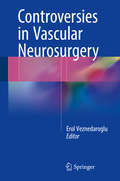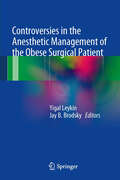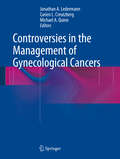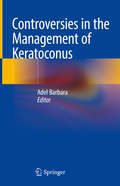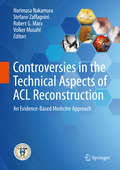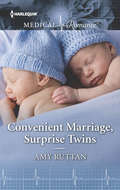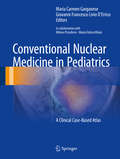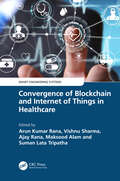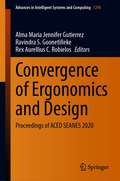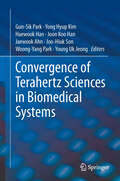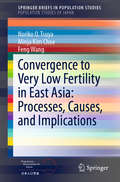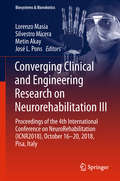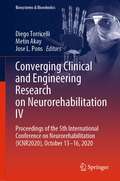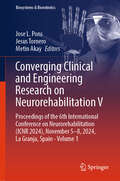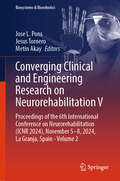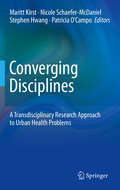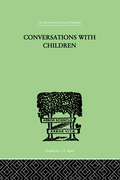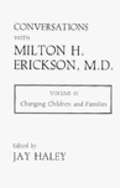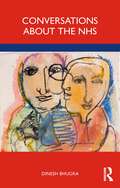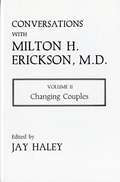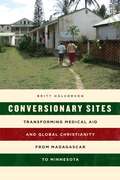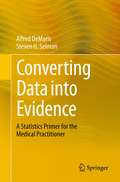- Table View
- List View
Controversies in Vascular Neurosurgery
by Erol VeznedarogluThis concise, easy-to-use book offers expert insights into current controversies in vascular neurosurgery with a view to providing the practitioner with authoritative practical guidance that will assist in the management of difficult disease entities. While vascular neurosurgery has undergone unprecedented advances during the past decade, enabling safer and easier access to previously untreatable pathology, this progress has been accompanied by confusion as to what constitutes best, or even acceptable, practice. Here, experts in the field discuss the various tools available and explain how best to use them when confronted by different pathologies, drawing upon their personal experience. Each chapter focuses on a specific case that is discussed by two experienced surgeons; a third author then evaluates the case, highlighting the available evidence and pearls in the treatment of that particular disease. The authors have been carefully chosen to provide a truly balanced viewpoint on paradigms that they themselves use. They therefore have a sound understanding of the thought processes of surgeons when dealing with challenging diseases for which there may be no single correct path. Furthermore, they are well placed to identify not only appropriate uses of new treatment options and technologies but also circumstances in which their use is best avoided. The ultimate benefactor of this book will be the patient: our biases as physicians should never become a patient's morbidity.
Controversies in the Anesthetic Management of the Obese Surgical Patient
by Jay B. Brodsky Yigal LeykinThe prevalence of obesity, an important risk factor for various diseases, has increased markedly worldwide in recent years. The results of long-term dietary behavioural therapy, however, remain sadly inadequate, with a relapse rate of about 90%. Surgery is still the only effective treatment for these patients. The annual number of weight loss operations performed in the United States in the early 1990s totaled only about 16,000, but by 2005 the figure exceeded 200,000. The anesthetic care of severely obese patients entails particular issues, and difficulties are believed to escalate in the presence of co-morbidities. Despite this, outcome data in respect of anesthetic care and pain management are still scarce. Anesthetic Management of the Obese Patient considers a wide range of important practical issues and controversies. Key questions in preoperative, intraoperative, and postoperative management are carefully addressed, and different approaches are evaluated, casting light on their effectiveness and limitations. Written by world leaders in the field, this book will be an invaluable aid for anesthesiologists.
Controversies in the Management of Gynecological Cancers
by Jonathan A. Ledermann Carien L. Creutzberg Michael A. QuinnThis is a novel text that highlights the controversial areas in the management of gynecological cancers. None of the topics in this book have definitive answers; they represent the everyday decision-making facing gynecologists, oncologists, radiologists, pathologists and other health professionals treating women with these conditions. This book is not to be used as a traditional textbook; it is a text that specialists and trainees will use to help them weigh up the arguments that exist in a variety of areas in the treatment of gynecological cancers. Each chapter will have two or more authors, selected either for their opposing views or for their ability to provide an opposite view or opinion to the other. The content will be evidence-based, illustrating contrasting evidence and scientific opinion in the literature. Each chapter will close on a summary indicating the direction of research needed to address the issues being discussed.
Controversies in the Management of Keratoconus
by Adel BarbaraThis book presents new technologies which are available now for the rehabilitation of visual acuity in patients suffering from keratoconusand for arresting the progression of this frustrating disease. All these current treatment options in differing combinations aim to improve the quality of life of the patients and although successful, they are causing confusion for the ophthalmologists; what procedure to do and when? How to perform? Which combination of treatments to choose? Controversies in the Management of Keratoconusprovidesthe widely used treatment options for keratoconus including collagen corneal cross –linking (CXL) covering all the available techniques, intrastromal corneal ring segments (ICRS) , phakic intra-ocular lenses (IOLs), photorefractive keratectomy (PRK) combined or not with CXL penetrating keratoplasty (PK) and deep anterior lamellar keratoplasty ( DALK). Each treatment is addressed by more than one author with different points of view in order to present the various approaches, the logic behind them and the most relevant clinical data available.A chapter by the editor tries to put some light on how to navigate among these controversies. This book will be of interest to trainees as well as the specialized ophthalmologists.
Controversies in the Technical Aspects of ACL Reconstruction: An Evidence-Based Medicine Approach
by Stefano Zaffagnini Robert G. Marx Norimasa Nakamura Volker MusahlThis book provides the reader with the best available evidence on the most pressing issues relating to reconstruction of the anterior cruciate ligament (ACL) with the goal of supporting surgical reconstruction of the ACL and improving outcomes for patients. Key topics for which evidence-based information is presented include selection of graft material and source, the use of different surgical techniques, graft rupture in relation to surgical technique, and progression to osteoarthritis. The book will aid the surgeon in making decisions with respect to fixation devices and tensioning, the bundles to be reconstructed, and whether to preserve remnants or partial bundle ruptures. An evidence-based stance is taken on evolving topics such as the anatomy of the tibial insertion site of the ACL and the role of the anterolateral capsule and posteromedial corner in high-grade rotatory instability. Furthermore, novel technical developments for measurement of knee laxity and soft tissue navigation are discussed. The reader will also find useful information on general issues concerning physical examination, arthroscopic setup, timing of reconstruction, anesthesia, and anticoagulation.
Convenient Marriage, Surprise Twins
by Amy RuttanOne wedding night... When Lana Haole reluctantly agrees to a marriage of convenience to help persuasive and all-too-tempting Dr. Andrew Tremblay stay in the country, the last thing she expects is to fall for the arrogant playboy's charms-on their wedding night... Twin consequences! Lana and Andrew agree it was a one-time-only deal...until they discover that Lana is pregnant with twins. Andrew won't walk away from his babies, or his beautiful bride, so he has eight months to convince Lana to stay his wife forever!
Conveniently Wed in Paradise: Winning The Surgeon's Heart / Conveniently Wed In Paradise (Mills And Boon Medical Ser.)
by Meredith WebberA marriage made on paper…A passion explored in paradise!When nurse Kenzie Steele takes a job as a companion for a wealthy lady on an idyllic Thai island, she’s certainly not looking for love. But to secure her family’s legacy, she does need a husband! Enter Alex McLeod, the charming A&E doctor whose grandmother’s dying wish is to see him happily married. Only, while their wedding in paradise is all business, their intense chemistry is anything but…“Really, the way this story started drew me into the story immediately…the chemistry between this couple was strong and kept getting the stronger….”—Harlequin Junkie on A Wife for the Surgeon Sheikh“With the books I’ve read by Ms. Webber so far, I’ve found her characters to be interesting and entertaining, and this couple are no different. Really, they have quite the history that had me reading quickly….”—Harlequin Junkie on Healed by Her Army Doc
Conventional Nuclear Medicine in Pediatrics: A Clinical Case-Based Atlas
by Maria Carmen Garganese Giovanni Francesco Livio D'ErricoThis superbly illustrated book combines the systematic approach of a textbook with the simplicity of consultation of an atlas in order to provide a comprehensive guide to the applications and benefits of scintigraphic studies in children. All of the clinical scenarios in which conventional nuclear medicine techniques frequently play a role in children are covered, with explanation of imaging diagnosis, the relevance of clinical history, problem solving, and pitfalls. The images themselves are the key focus of the book, and in each setting the added value offered by scintigraphy is carefully identified. The book also describes management of the pediatric patient and addresses general considerations, including reception, interaction with parents, radiopharmaceutical administration, image acquisition, radiation exposure, and the relationship of nuclear medicine and radiology. Since the child is not a young adult, it is insufficient simply to adapt nuclear medicine procedures performed in adults to the age and size of the child. Conventional Nuclear Medicine in Pediatrics will be a rich source of information for all who perform these procedures in the pediatric setting.
Convergence of Blockchain and Internet of Things in Healthcare (Smart Engineering Systems: Design and Applications)
by Arun Kumar Rana, Vishnu Sharma, Ajay Rana, Maksud Alam and Suman Lata TripathiThe Internet of Things (IoT) and blockchain are two new technologies that combine elements in many ways. A system where the virtual and physical worlds interact is created by integrating pervasive computing, ubiquitous computing, communication technologies, sensing technologies, Internet Protocol, and embedded devices. A massive number of linked devices and vast amounts of data present new prospects for developing services that can directly benefit the economy, environment, society, and individual residents. Due to the size of IoT and insufficient data security, security breaches may have a huge impact and negative effects. IoT not only connects gadgets but also people and other entities, leaving every IoT component open to a wide variety of assaults. The implementation and application of IoT and blockchain technology in actual scientific, biomedical, and data applications are covered in this book. The book highlights important advancements in health science research and development by applying the distinctive capabilities inherent to distributed ledger systems. Each chapter describes the current uses of blockchain in real-world data collection, medicine development, device tracking, and more meaningful patient interaction. All of these are used to create opportunities for expanding health science research. This paradigm change is studied from the perspectives of pharmaceutical executives, biotechnology entrepreneurs, regulatory bodies, ethical review boards, and blockchain developers.Key Features: Provides a foundation for the implementation process of blockchain and IoT devices based on healthcare-related technology Image processing and IoT device researchers can correlate their work with other requirements of advanced technology in the healthcare domain Conveys the latest technology, including artificial intelligence and machine learning, in healthcare-related technology Useful for the researcher to explore new things like security, cryptography, and privacy in healthcare related technology Tailored for people who want to start in healthcare-related technology with blockchain and IoT This book is primarily for senior undergraduates, graduate students, and academic researchers in the fields of electrical engineering, electronics and communication engineering, computer science and engineering, and biomedical engineering.
Convergence of Ergonomics and Design: Proceedings of ACED SEANES 2020 (Advances in Intelligent Systems and Computing #1298)
by Ravindra S. Goonetilleke Alma Maria Jennifer Gutierrez Rex Aurellius C. RobielosThis book presents the proceedings of the Joint Conference of the Asian Council on Ergonomics and Design and Southeast Asian Network of Ergonomics Societies (ACED SEANES), held on December 2-4, 2020. By highlighting the latest theories and models, as well as cutting-edge technologies and applications, and by combining findings from a range of disciplines including engineering, design, robotics, healthcare, management, computer science, human biology and behavioral science, it provides researchers and practitioners alike with a comprehensive, timely guide on human factors and ergonomics. It also offers an excellent source of innovative ideas to stimulate future discussions and developments aimed at applying knowledge and techniques to optimize system performance, while at the same time promoting the health, safety and wellbeing of individuals. The proceedings include papers from researchers and practitioners, scientists and physicians, institutional leaders, managers and policy makers that contribute to constructing the Human Factors and Ergonomics approach across a variety of methodologies, domains and productive sectors.
Convergence of Terahertz Sciences in Biomedical Systems
by Gun-Sik Park Haewook Han Jaewook Ahn Joo-Hiuk Son Joon Koo Han Woong-Yang Park Yong Hyup Kim Young Uk JeongRecent technological breakthrough in the field of Terahertz radiation has triggered new applications in biology and biomedicine. Particularly, biological applications are based on the specific spectroscopic fingerprints of biological matter in this spectral region. Historically with the discovery of new electromagnetic wave spectrum, we have always discovered new medical diagnostic imaging systems. The use of terahertz wave was not realized due to the absence of useful terahertz sources. Now after successful generation of THz waves, it is reported that a great potential for THz wave exists for its resonance with bio-molecules. There are many challenging issues such as development of THz passive and active instrumentations, understanding of THz-Bio interaction for THz spectroscopy, THz-Bio nonlinear phenomena and safety guideline, and THz imaging systems. Eventually the deeper understanding of THz-Bio interaction and novel THz systems enable us to develop powerful THz biomedical imaging systems which can contribute to biomedical industry. This is a truly interdisciplinary field and convergence technology where the communication between different disciplines is the most challenging issue for the success of the great works. One of the first steps to promote the communications in this convergence technology would be teaching the basics of these different fields to the researchers in a plain language with the help of Convergence of Terahertz Science in Biomedical Systems which is considered to be 3-4th year college students or beginning level of graduate students. Therefore, this type of book can be used by many people who want to enter or understand this field. Even more it can be used for teaching in universities or research institutions.
Convergence to Very Low Fertility in East Asia: Fertility Declines In Japan, South Korea, And China (SpringerBriefs in Population Studies)
by Feng Wang Minja Kim Choe Noriko O. TsuyaThis book examines the trends, underlying factors, and policy implications of fertility declines in three East Asian countries: Japan, South Korea, and China. In contrast to Western countries that have also experienced fertility declines to below-replacement levels, fertility decline in these East Asian countries is most notable in its rapidity and sheer magnitude. After a rapid decline shortly after the war, in which fertility was halved in one decade from 4.5 children per woman in 1947 to 2.1 in 1957, Japan's fertility started to decline to below-replacement levels in the mid-1970s, reaching 1.3 per woman in the early 2000s. Korea experienced one of the most spectacular declines ever recorded, with fertility falling continuously from very high (6.0 per woman) to a below-replacement level (1.6 per woman) between the early 1960s and mid-1980s, reaching 1.1 per woman in 2005. Similarly, after a dramatic decline from very high to low levels in one decade from the early 1970s to early 1980s, China's fertility reached around 1.5 per woman by 2005. Despite differences in timing, tempo, and scale of fertility declines, dramatic fertility reductions have resulted in extremely rapid population aging and foreshadow a long-term population decline in all three countries. This monograph provides a systematic comparison of fertility transitions in these East Asian countries and discusses the economic, social, and cultural factors that may account for their similarities and differences. After an overview of cultural backgrounds, economic transformations, and the evolution of policies, the trends and age patterns of fertility are examined. The authors then investigate changes in women's marriage and childbearing within marriage, the two major direct determinants of fertility, followed by an analysis of the social and economic factors underlying fertility and nuptiality changes, such as education, women's employment, and gender relations at home.
Convergence: Proceedings of the International Conference on Healthcare Systems Ergonomics and Patient Safety, HEPS2022 (Springer Series in Design and Innovation #30)
by Richard H. M. Goossens Marijke Melles Armaĝan AlbayrakThis book presents the proceedings of the 7th conference Healthcare Systems Ergonomics and Patient Safety (HEPS), held in Delft, The Netherlands on November 2-4, 2022, which was endorsed by the International Ergonomics Association (IEA). Contributions focus on the integration of knowledge, methods, and expertise from the disciplines of Human Factors/Ergonomics and of Medicine and Health in order to contribute to a safe and humane, high-quality healthcare system. Through breaking down the barriers between disciplines, they foster a framework of scientific knowledge, expertise and best practices to create the future of health and healthcare. The proceedings include papers from researchers and practitioners, scientists and physicians, institutional leaders, managers and policy makers that contribute to constructing the Human Factors and Ergonomics approach across a variety of methodologies, domains and productive sectors.
Converging Clinical and Engineering Research on Neurorehabilitation III: Proceedings of the 4th International Conference on NeuroRehabilitation (ICNR2018), October 16-20, 2018, Pisa, Italy (Biosystems & Biorobotics #21)
by Metin Akay José L. Pons Lorenzo Masia Silvestro MiceraThe book reports on advanced topics in the areas of neurorehabilitation research and practice. It focuses on new methods for interfacing the human nervous system with electronic and mechatronic systems to restore or compensate impaired neural functions. Importantly, the book merges different perspectives, such as the clinical, neurophysiological, and bioengineering ones, to promote, feed and encourage collaborations between clinicians, neuroscientists and engineers. Based on the 2018 International Conference on Neurorehabilitation (ICNR 2018) held on October 16-20, 2018, in Pisa, Italy,, this book covers various aspects of neurorehabilitation research and practice, including new insights into biomechanics, brain physiology, neuroplasticity, and brain damages and diseases, as well as innovative methods and technologies for studying and/or recovering brain function, from data mining to interface technologies and neuroprosthetics. In this way, it offers a concise, yet comprehensive reference guide to neurosurgeons, rehabilitation physicians, neurologists, and bioengineers. Moreover, by highlighting current challenges in understanding brain diseases as well as in the available technologies and their implementation, the book is also expected to foster new collaborations between the different groups, thus stimulating new ideas and research directions.
Converging Clinical and Engineering Research on Neurorehabilitation IV: Proceedings of the 5th International Conference on Neurorehabilitation (ICNR2020), October 13–16, 2020 (Biosystems & Biorobotics #28)
by Metin Akay Diego Torricelli Jose L. PonsThe book reports on advanced topics in the areas of neurorehabilitation research and practice. It focuses on new methods for interfacing the human nervous system with electronic and mechatronic systems to restore or compensate impaired neural functions. Importantly, the book merges different perspectives, such as the clinical, neurophysiological, and bioengineering ones, to promote, feed and encourage collaborations between clinicians, neuroscientists and engineers. Based on the 2020 International Conference on Neurorehabilitation (ICNR 2020) held online on October 13-16, 2020, this book covers various aspects of neurorehabilitation research and practice, including new insights into biomechanics, brain physiology, neuroplasticity, and brain damages and diseases, as well as innovative methods and technologies for studying and/or recovering brain function, from data mining to interface technologies and neuroprosthetics. In this way, it offers a concise, yet comprehensive reference guide to neurosurgeons, rehabilitation physicians, neurologists, and bioengineers. Moreover, by highlighting current challenges in understanding brain diseases as well as in the available technologies and their implementation, the book is also expected to foster new collaborations between the different groups, thus stimulating new ideas and research directions.
Converging Clinical and Engineering Research on Neurorehabilitation V: Proceedings of the 6th International Conference on Neurorehabilitation (ICNR 2024), November 5–8, 2024, La Granja, Spain - Volume 1 (Biosystems & Biorobotics #31)
by Metin Akay Jose L. Pons Jesus TorneroThe book reports on advanced topics in the areas of neurorehabilitation research and practice. It focuses on new methods for interfacing the human nervous system with electronic and mechatronic systems to restore or compensate impaired neural functions. Importantly, the book merges different perspectives, such as the clinical, neurophysiological, and bioengineering ones, to promote, feed and encourage collaborations between clinicians, neuroscientists and engineers. Based on the 2024 International Conference on Neurorehabilitation (ICNR2024) held in La Granja, Spain on November 5-8, 2024, this book covers various aspects of neurorehabilitation research and practice, including new insights into biomechanics, brain physiology, neuroplasticity, and brain damages and diseases, as well as innovative methods and technologies for studying and/or recovering brain function, from data mining to interface technologies and neuroprosthetics. In this way, it offers a concise, yet comprehensive reference guide to neurosurgeons, rehabilitation physicians, neurologists, and bioengineers. Moreover, by highlighting current challenges in understanding brain diseases as well as in the available technologies and their implementation, the book is also expected to foster new collaborations between the different groups, thus stimulating new ideas and research directions.
Converging Clinical and Engineering Research on Neurorehabilitation V: Proceedings of the 6th International Conference on Neurorehabilitation (ICNR 2024), November 5–8, 2024, La Granja, Spain - Volume 2 (Biosystems & Biorobotics #32)
by Metin Akay Jose L. Pons Jesus TorneroThe book reports on advanced topics in the areas of neurorehabilitation research and practice. It focuses on new methods for interfacing the human nervous system with electronic and mechatronic systems to restore or compensate impaired neural functions. Importantly, the book merges different perspectives, such as the clinical, neurophysiological, and bioengineering ones, to promote, feed and encourage collaborations between clinicians, neuroscientists and engineers. Based on the 2024 International Conference on Neurorehabilitation (ICNR2024) held in La Granja, Spain on November 5-8, 2024, this book covers various aspects of neurorehabilitation research and practice, including new insights into biomechanics, brain physiology, neuroplasticity, and brain damages and diseases, as well as innovative methods and technologies for studying and/or recovering brain function, from data mining to interface technologies and neuroprosthetics. In this way, it offers a concise, yet comprehensive reference guide to neurosurgeons, rehabilitation physicians, neurologists, and bioengineers. Moreover, by highlighting current challenges in understanding brain diseases as well as in the available technologies and their implementation, the book is also expected to foster new collaborations between the different groups, thus stimulating new ideas and research directions.
Converging Disciplines: A Transdisciplinary Research Approach to Urban Health Problems
by Stephen Hwang Nicole Schaefer-Mcdaniel Maritt Kirst Patricia O'CampoAs urban populations grow, new health problems evolve in tandem with longstanding issues. And as a welter of social, environmental, and access factors further complicate the picture, workable solutions require increasingly sophisticated understanding and innovative methods--generally beyond the scope of one professional field. Converging Disciplines introduces the concept of transdisciplinary research as a multidimensional, research-to-practice approach to urban health issues, not only bringing researchers together but also linking stakeholders, from practitioners to policymakers to community members. This immediately accessible volume differentiates transdisciplinary research from multi- and interdisciplinary strategies, as well as from popular community-based models, and brings a uniquely North American set of perspectives to the concept. Chapter authors explore the theory behind the methods as well as their application in meeting chronic problems (e.g., domestic violence, substance abuse) and working with vulnerable populations (e.g., homeless individuals, refugees) in ways that are ecologically based, ethically sound, and eminently practical. Key areas of coverage: Benefits and challenges of transdisciplinary research in the urban health setting. Transdisciplinary research process, including methodologies, collaboration, and information sharing. Detailed case examples of transdisciplinary research used in addressing health issues among marginalized urban populations. An overview of training programs in the U.S. and Canada. The view from funding agencies. Preparing the university, researchers, and the job market for a transdisciplinary future researchers and graduate students in urban and public health will find inspiring reading in Converging Disciplines: a bold framework for transforming their fields, and the tools for meeting the new generation of urban health challenges.
Conversations With Children
by Katz, David & Katz, RosaFirst published in 1999. Routledge is an imprint of Taylor & Francis, an informa company.
Conversations With Milton H. Erickson: Changing Children and Families Volume 3
by Jay HaleyThese conversations took place over a period of 17 years and were recorded as part of Gregory Bateson's project on communication and therapy...specializing in the study of Erickson's ways of changing human beings.
Conversations about the NHS
by Dinesh BhugraAs the National Health Service celebrates 75 years, this book reflects not only on its successes but also on its challenges. Society, medicine and technology have all changed considerably since its founding in 1948 so what can, and should, the NHS do to adapt to remain fit for purpose? This thought-provoking book is made up of interviews with healthcare leaders, policymakers and practitioners, journalists and patient representatives. Bookended with chapters linking the interviews with the history and the future of the NHS, the book addresses questions such as: What are the NHS’s strengths and weaknesses? How could the NHS be adapted and how should it be set up if founded today? How should the NHS recognised the relationship between physical health, mental health, social care and public health? How should the NHS be funded? How do we understand the social contract between patients, medical and allied professions and the government? How can we manage workforce development? How should the NHS address issues around social justice and equity of access? Timely and important, this book promotes debate and critique around key issues in managing healthcare. Relevant to all those working in the NHS, it is also a valuable contribution for healthcare professionals undertaking further study on management and leadership. All royalties from this book are being donated to The Patients Association.
Conversations with Milton H. Erickson, M.D.: Changing Couples
by Milton H. Erickson Jay HaleyIf one could ask Milton Erickson anything one wishes about how to change people, the result would be these conversations. There are three volumes in this series. In this volume, approaching marital couples in his unique ways, Erickson talks about the issues of marriage and show many procedures for resolving problems.
Conversionary Sites: Transforming Medical Aid and Global Christianity from Madagascar to Minnesota
by Britt HalvorsonDrawing on more than two years of participant observation in the American Midwest and in Madagascar among Lutheran clinicians, volunteer laborers, healers, evangelists, and former missionaries, Conversionary Sites investigates the role of religion in the globalization of medicine. Based on immersive research of a transnational Christian medical aid program, Britt Halvorson tells the story of a thirty-year-old initiative that aimed to professionalize and modernize colonial-era evangelism. Creatively blending perspectives on humanitarianism, global medicine, and the anthropology of Christianity, she argues that the cultural spaces created by these programs operate as multistranded “conversionary sites,” where questions of global inequality, transnational religious fellowship, and postcolonial cultural and economic forces are negotiated. A nuanced critique of the ambivalent relationships among religion, capitalism, and humanitarian aid, Conversionary Sites draws important connections between religion and science, capitalism and charity, and the US and the Global South.
Converting Data into Evidence: A Statistics Primer for the Medical Practitioner
by Alfred Demaris Steven H. SelmanConverting Data into Evidence: A Statistics Primer for the Medical Practitioner provides a thorough introduction to the key statistical techniques that medical practitioners encounter throughout their professional careers. These techniques play an important part in evidence-based medicine or EBM. Adherence to EBM requires medical practitioners to keep abreast of the results of medical research as reported in their general and specialty journals. At the heart of this research is the science of statistics. It is through statistical techniques that researchers are able to discern the patterns in the data that tell a clinical story worth reporting. The authors begin by discussing samples and populations, issues involved in causality and causal inference, and ways of describing data. They then proceed through the major inferential techniques of hypothesis testing and estimation, providing examples of univariate and bivariate tests. The coverage then moves to statistical modeling, including linear and logistic regression and survival analysis. In a final chapter, a user-friendly introduction to some newer, cutting-edge, regression techniques will be included, such as fixed-effects regression and growth-curve modeling. A unique feature of the work is the extensive presentation of statistical applications from recent medical literature. Over 30 different articles are explicated herein, taken from such journals. With the aid of this primer, the medical researcher will also find it easier to communicate with the statisticians on his or her research team. The book includes a glossary of statistical terms for easy access. This is an important reference work for the shelves of physicians, nurses, nurse practitioners, physician's assistants, medical students, and residents.
